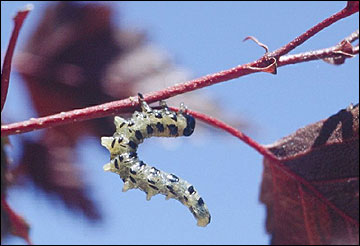Dusty birch sawfly
Sawflies
 Dusty birch sawfly caterpillars (Croesus latitarsus) are present in summer and fall. They produce two to three generations per year.
Dusty birch sawfly caterpillars (Croesus latitarsus) are present in summer and fall. They produce two to three generations per year.
Full-grown caterpillars are nearly one inch long. They have black heads and a yellow-green body with longitudinal rows of black spots (including a row beneath the spiracles). There are seven pairs of yellow-green prolegs. The caterpillars are gregarious and prefer to feed on birch (various species).
About the order
Most species in the order Hymenoptera are beneficial to agriculture as either important pollinators or as biological control agents that prey upon pestiferous insects. However, the hymenopteran group known as "sawflies" feed upon plant tissue and at times can cause serious defoliation. While adult sawflies resemble a wasp or a bee, immature sawflies are caterpillar-like, resembling the immature stage of moths or butterflies. A good diagnostic characteristic that can be used to distinguish between lepidopteran and hymenopteran "caterpillars" is the number of prolegs on the abdomen. Moth and butterfly caterpillars usually have five pairs of prolegs, four pairs on the mid-abdomen and one pair at the end of the abdomen (referred to as anal prolegs). In contrast, sawfly caterpillars typically have six or more pairs of prolegs on the abdomen. Sawfly larvae can cause significant damage to many forest trees (conifer and broadleaf) and landscape trees and shrubs.